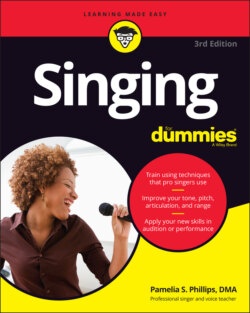Читать книгу Singing For Dummies - Pamelia S. Phillips - Страница 17
Working the Different Parts of Your Voice
ОглавлениеYour goal is to make your singing voice sound like one smooth line from top to bottom. Your voice may have a few bumps and wiggles as you work your way up and down. That’s perfectly normal, but help is right at hand. Chapters 11 and 12 work with specific areas of the voice called registers — chest voice, middle voice, and head voice. In these chapters, you can discover what each part of the voice feels like and what to do with it. When you’re ready, try these tips:
Strengthening your middle, chest, and head voice to get a complete vocal workout: The first step in the workout for the voice is to find the different registers of the voice and then notice what each feels like. After you find them, you want to try to smooth the transition between registers. You may find that your chest voice and head voice feel miles apart. The exercises in Chapters 11 and 12 are designed to help you smooth out the bumps. You may not think the exercises are easy in the beginning, which is good. I don’t want you to be bored. Even if you’ve never explored any vocal sounds, you can figure out these exercises and get your voice in good working order — it just takes some time and patience.Chapter 12 helps you refine your register transitions and extend your range. Some songs require flexibility, and the exercises in the chapter help you develop agility and even try out your agility in some pop riffs.
Adding belting technique to your list of skills: Your speaking voice needs a workout to get you started on belting. Belting is the sound that you want to make for musical theater or pop-rock songs. The exercises start from the beginning, so you don’t have to know anything about belting to take on the information in Chapter 13.
